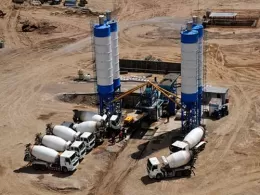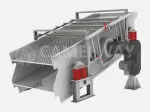Concrete is a composite material made of aggregate together with liquid cement. The major components of concrete are cement, water, and aggregates (fines and coarse aggregate) with aggregates taking about 50 to 60% of the total volume, depending on the mix proportion. The amount of concrete used worldwide is twice that of steel, wood, plastic, and aluminum combined.
Concrete can be used either singular or reinforced with steel in order to achieve the required strength. Concrete builds durable, long lasting structures that will not rust, rot, or burn. It is widely used for making architectural structures, foundations, brick walls, bridges and many other civil engineering work. Concrete is used in large quantities almost everywhere mankind has a need for infrastructure because of its high strength and durability.

The strength of concrete is one of major properties that structural engineers take into consideration before erecting any structure. This property can be affected by many factors including water to cement ratio, degree of compaction, aggregate size and shape to name a few. Aggregate gradation plays an important role in concrete mixing. Unsatisfactory gradation of aggregates will lead to segregation of mortar from the coarse aggregates,internal bleeding, need for chemical admixtures to restore work-ability, excessive water use and increased cement use.
Aggregates constitute about 50 to 60% of the concrete mix depending on the mix proportion used. The greater the proportion of aggregate in concrete mixture, the greater the contribution to its strength. Aggregates are the most mined material in the world. They are a component of composite materials such as concrete and asphalt concrete. The aggregates are responsible for the unit weight, elastic modulus and dimensional stability of concrete because these properties depend on the physical characteristics (strength and bulk density) of the aggregate.

Given a constant water to cement ratio (0.5) and mix (1:2:4), a change in coarse aggregate size affected the work-ability (slump) of concrete. The work-ability (slump) was directly proportional to the aggregate size. 9.5 mm, 13.2 mm and 19.0 mm increased from 10.0 mm, 13.5 mm to 20.0 mm respectively. As the slump increased, the concrete became more workable.The mean strength of the concrete aggregates was assessed and found to increase with increasing aggregates size. The aggregate sizes 9.5 mm, 13.2 mm and 19.0 mm had mean strengths of 15.34 N/mm2, 18.61 N/mm2 and 19.48 N/mm2, respectively. The 9.5 mm and 19.0 mm course aggregate sizes were significantly different (P < 0.05; 0.034). However, there was no significant difference in the strength between 13.2 mm and 19.0 mm aggregates (P > 0.05; 0.585).












0 Comment